

Fini le journalisme de flux ! Vive le journalisme de stock ! (version réactualisée avec des exemples français)

Vox is publishing some of its stories and the interviews behind them in parallel. It’s a small thing, but worth noting: For stories that are built around a single interview, Vox is now publishing both the story and the interview transcript in parallel.

Take this Thomas Piketty piece by Matt Yglesias, for instance: story and interview, both on the same page (html-wise, if not visually), with a button toggle between them. Is this revolutionary? Nope. But think about the small good things it does: — It presents content in two different forms. . — It does so at virtually no cost; the interview’s already complete. . — It opens up the possibility of richer testing and audience data. Is it perfect? At the time, the switcher was only at the top of the page, and the two states shared the same URL — it was impossible to link directly to the interview.
When starting from zero in journalism go for a niche site serving a narrow news interest well. Mar.26 In 1994 we would not have advised beginners in journalism: start your own trade magazine!
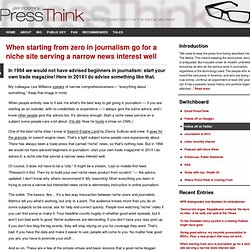
Here in 2014 I do advise something like that. My colleague Lisa Williams speaks of narrow comprehensiveness— “everything about something.” Keep that image in mind. When people entirely new to it ask me what’s the best way to get going in journalism — if you are starting as an outsider, with no credentials or experience — I always give the same advice, and I know other people give this advice too. De Vox Media à Vice, les médias en ligne qui marchent - Entreprises. Ces projets qui vont dépoussiérer le journalisme en ligne. Digital First Media's Project Unbolt: Everything you need to know.
Digital First Media newsrooms are still largely print newsrooms with digital operations “bolted on.”
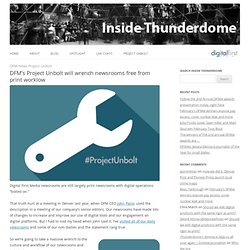
That truth hurt at a meeting in Denver last year, when DFM CEO John Paton used the description in a meeting of our company’s senior editors. Our newsrooms have made lots of changes to increase and improve our use of digital tools and our engagement on digital platforms. News Websites Proliferate, Stretching Thin Ad Dollars. Facebook Is Seeking “Editors” for News App. For years, Facebook has sworn by the power of algorithms to serve users a personalized mix of status updates, stories and photos.
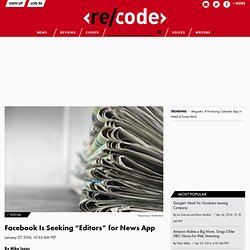
It’s what makes up the heart of the company’s premier product, the News Feed. Soon, Facebook will add another approach to delivering the news: Via a new app, humans working for Facebook will start telling you which news stories you should be reading. Over the past few months, Facebook has sought to hire contract editors to staff up Paper, the company’s unreleased, Flipboard-like news aggregation mobile app, according to two people familiar with the matter. These editors, sources said, will oversee around ten different news verticals on a wide range of topics, curating a mix of the “best stories” within each particular subject area for users to see. The Paper verticals will be filled with stories picked entirely by these editors.
A Facebook spokesperson declined to comment. Jason Calacanis launches Inside, a mobile news-curation app powered by humans. Jason Calacanis, the man behind media startups like Mahalo and Weblogs Inc., has his sights set on a new frontier that he thinks could be as promising as blogs were in the early part of this decade: namely, mobile content curation.

On Tuesday, he and former Atlantic Wire editor Gabriel Snyder are launching a new iOS app and website called Inside that Calacanis says will give users access to the best journalism and media on the web, powered by human editors. Calacanis, who is also a venture investor and the founder of the Launch conference for startups, said in an interview that he has been working on the ideas behind the app for some time, and that his “Launch Ticker” email newsletter was a kind of alpha version of what has become Inside — in the sense that it was intended to give readers a quick summary of all the tech news they needed to know.
The newsletter got more than 5,000 signups and about 700 of those converted to paying $100 a year after it went paid access, he said. Le fondateur d'Inside.com s'attaque aux Buzzfeed, Business Insider et consorts. “I see this as the next CNN”: Jason Calacanis’ Inside.com aims to solve news on mobile devices. In the 13-plus years since the original ahead-of-its-time Inside.com launched, it’s been part of a Steve Brill mashup, a dead domain, a planned flagship brand that didn’t happen, and a dormant asset waiting to be exploited.

For most of that time, tech publishing entrepreneur Jason Calacanis wanted it. He was finally able to snag it from its most recent owner, Guardian News & Media, popping up a placeholder that stayed up longer than expected. Today, the placeholder came off and Inside came back in a guise few would have predicted: a mobile-first general news app and companion site based on OPJ: Other People’s Journalism.
It’s an evolution for Calacanis, whose own history illustrates the past decade’s shifts in tech journalism and the startup culture. The new Inside is his multiple-choice answer to that quandary, his theory about the future of news and a desire to leave a media legacy. Jason Calacanis’ Mahalo Is Reborn As Mobile News App Inside. Jason Calacanis is getting back into the news business with a new app called Inside, which highlights and summarizes the top news stories.
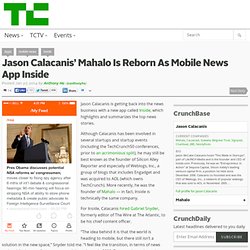
Although Calacanis has been involved in several startups and startup events (including the TechCrunch50 conferences, prior to an acrimonious split), he may still be best known as the founder of Silicon Alley Reporter and especially of Weblogs, Inc., a group of blogs that includes Engadget and was acquired to AOL (which owns TechCrunch). More recently, he was the founder of Mahalo — in fact, Inside is technically the same company. For Inside, Calacanis hired Gabriel Snyder, formerly editor of The Wire at The Atlantic, to be his chief content officer. “The idea behind it is that the world is heading to mobile, but there still isn’t a solution in the new space,” Snyder told me.
Comment The Atlantic a-t-il doublé le nombre de ses journalistes en 5 ans ? Même datant du 19ème siècle, sans mur payant en ligne, diffusé en entier gratuitement sur le web, et sans lol cat, le magazine américain The Atlantic est parvenu à multiplier par deux la taille de sa rédaction depuis 2009 et à gagner de l’argent depuis 2010.
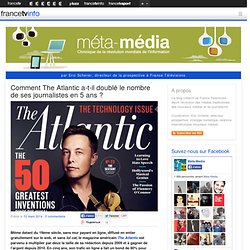
En cinq ans, son trafic en ligne a fait un bond de 80% pour atteindre 25 millions de visiteurs uniques par mois sans compromis sur la qualité. Et le mensuel reste le plus influent des Etats-Unis !